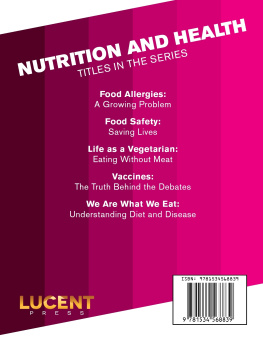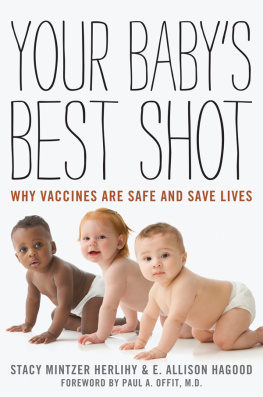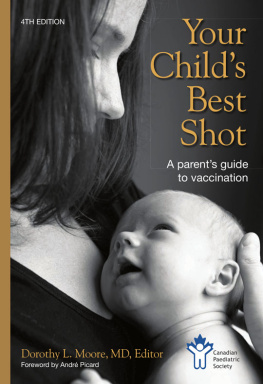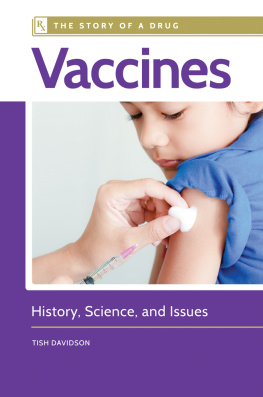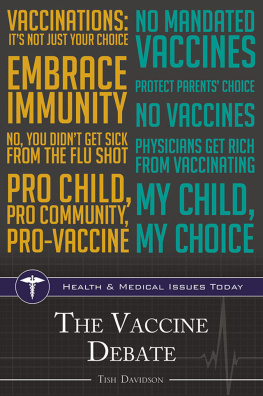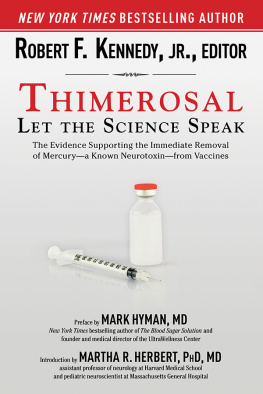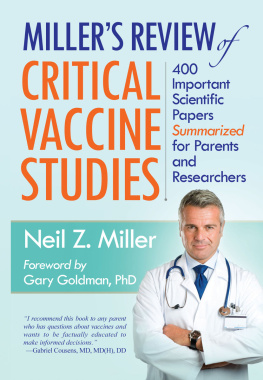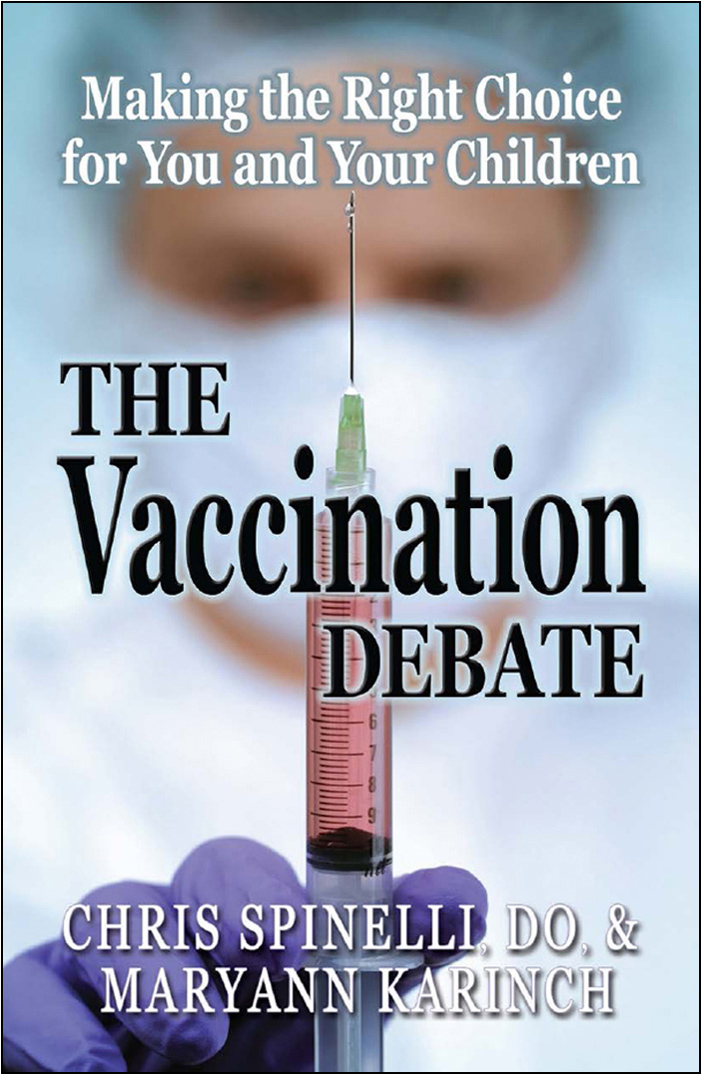

Copyright 2015 by Chris Spinelli and Maryann Karinch
All rights reserved. No portion of this book may be reproduced or transmitted in any form whatsoever, including electronic, mechanical or any information storage or retrieval system, except as may be expressly permitted in the 1976 Copyright Act or in writing from the publisher.
Requests for permission should be addressed to:
New Horizon Press
P. O. Box 669
Far Hills, NJ 07931
Chris Spinelli, DO, and Maryann Karinch
The Vaccination Debate:
Making the Right Choice for You and Your Children
Cover design: Charley Nasta
Interior design: Scribe Inc.
Library of Congress Control Number: 2014957544
ISBN-13 (eBook): 9780-882825069
New Horizon Press
19 18 17 16 15 1 2 3 4 5
Table of Contents
Guide

Table of Contents

Dedications
To my wife and children, whose support I greatly appreciate, plus the current and former members of the United States military. Thank you for all youve done for the citizens of our country and those around the world.
Chris Spinelli
Thank you to my mother, whose high standards as a nurse and a parent put me on a good path from the start; to my brother, who helps me lighten up; and to Jim, who is there for me every day of every year.
Maryann Karinch
To Rotary International, whose efforts to help eradicate polio worldwide have reduced the number of cases by 99 percent in the past thirty years.
Chris and Maryann

Asked about whether vaccines for childhood diseases such as measles, mumps, rubella (MMR) and polio should be required or left up to parental choice, 68 percent of adults say such vaccines should be required while 30 percent say that parents should be able to decide whether or not to vaccinate their children.
Pew Research Center
W hen one-third of a population does not buy into the value of a common medical practice, its time to air the scienceall relevant parts of itrather than throw the dissenters in jail, fine them or mock them in the media.
According to a website supported by The College of Physicians of Philadelphia (historyofvaccines.org), the Chinese introduced the first vaccine around 1000 CE. It was a smallpox inoculation (or variolation, as it was called at the time) and use of the smallpox material to prevent the disease spread to Africa and Turkey and then on to Europe and the Americas.
However, a friend of coauthor Maryann thinks the concept of using the source of illness to prevent or cure an illness can be tracked to an earlier time. The friend said, Take a look at Numbers, which is one of the books of the Old Testament in the Bible. It could be argued that the passage about the healing power of a serpent-twined rodone of several links to the symbol of modern medicinealso hints at the concept of vaccination. The upshot of the Prophet Moses message, loosely translated, goes like this: Dont worry about dying from a snake bite, because God made it possible for the snake Ive got wrapped around this pole to save your life.
We can probably assume that there were both Chinese and Israelites who argued that what they were being told didnt make sense. Dissenters have been around for quite a while.
There have been dissenters in both the twentieth and twenty-first centuries, long before model Jenny McCarthy became an evangelist about a possible link between vaccinations and autism. A study published in the Yale Journal of Biology and Medicine spotlights references to vaccines in newspaper articles between 1915 and 1922 that call it poisonous, filthy, loathsome, damnable stuff.
Regardless of who figured out that illnesses could be controlled or even eradicated through the use of disease material, there are plenty of people who now think the concept is horrible. A violation of nature. A tool of the government to control people.
This book illuminates key arguments in the vaccination debate and states, with as much scientific power as possible, what drives the anti-vaccination contingent as well as what the pro-vaccination community stands on as evidence of the necessity of vaccinating our population.
We, the authors, believe that vaccines are some of the most important public health tools. At the same time, we are aware that people who dont agree want their arguments put into the context of a legitimate debate.
In this book, the debate encompasses the science behind and the science (when it exists) against each type of vaccine, as well as the timing of vaccinations, natural immunities, homeopathy and the use of heavy metals and other additives.
We also look at the future of vaccinations. Currently, twenty vaccines are in common use and new techniques for developing vaccines give scientists hope of generating immunity against parasitic diseases such as malaria. Will humans one day have dozens of vaccines available so anyone with access to good medical care theoretically wouldnt have to worry about HIV, Ebola or even different kinds of cancer? The HIV vaccine has been in development for twenty years at this point and is in clinical trials, so this is more leading-edge medicine than futuristic medicine. But in the future, will only pediatricians, family practitioners, internists (who commonly administer the vaccines) and people like radiologists and orthopedic surgeons (who document and fix injuries that vaccines cant prevent) be nearly the only physicians with job security?
The vaccination debate is complicated.
Thirty percent of Americans and many more people worldwide have genuine concerns, fears or serious questions about vaccines. This book is meant to engage the questions, assertions and feelings of both sides so that a meaningful decision can be made as to what is best for both you and your children.
Chris Spinelli, DO, and Maryann Karinch

A re vaccines heroes or villains?
In this chapter we utilize a foundational discussion of disease prevention versus health risks. By health risks, we mean the health conditions that some people assert are caused by vaccines.
According to a poll conducted by the C.S. Mott Childrens National Poll on Childrens Health, 89 percent of the 1,621 parents who participated rated vaccine safety as the most important topic in childrens health research today.
The two other big topics were concerns about things in the environment that could lead to health issues and new treatments for rare childhood diseases at 72 percent and 66 percent, respectively. Parents worry about their children getting sick, how to prevent illness and then how to take care of them when they do have health conditions.


